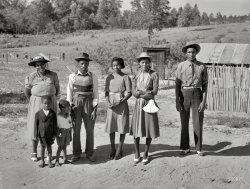
MAY CONTAIN NUTS

Search Shorpy
SHORPY ART

Framed or unframed, desk size to sofa size, printed by us in Arizona and Alabama since 2007. Explore now.
Join and Share
Ad-Free Shorpy
Shorpy is funded by you. Patreon contributors get an ad-free experience.
Learn more.

Recent comments
- Recent view
- Hudson’s Big Store
- Say what??
- Grapes?!
- A Beautiful Moment
- Such joy
- Bethune-Cookman University today...
- Yellow sky at morning
- Side Winder
- Air Quality?
- Sojourner Truth riot
- None were so blind(ed)
- The less famous sister
- Good ol' days?
- Rise and Fall
- Goo Goo Ga Joob
- Ticket Retention
- Not the only one
- Vagaries of War
- Killed by Amtrak
- Back to the Future
- Wanted --
- If you can't stand the light
- Centralized Traffic Control, I believe
- What's really happening
- Heckuva remote control!
- Sometimes — Things Go Bump!
- I SEE THE LIGHT
- Union Switch and Signal Company
- Get That Light Out Of My Eyes
Member Photos
The Shorpy
Print Emporium
Print Emporium
Search Shorpy
Search results -- 30 results per page
- American Garage: 1943
- ... locomotive shops." Medium-format nitrate negative by Jack Delano for the Farm Security Administration. View full size.
... types but of 2 different designs.
(The Gallery, Jack Delano, Railroads) ... Posted by Dave - 06/10/2009 - 11:43am -
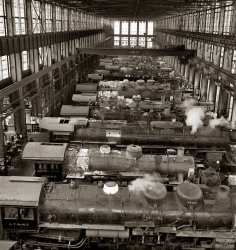
- The Industrial Orange: 1943
- ... plant, Redlands, Calif." Kodachrome transparency by Jack Delano for the Office of War Information. View full size.
The crate was ... Posted by Dave - 02/09/2022 - 12:40pm -
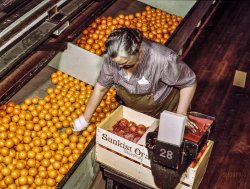
- Parked Girl: 1941
- ... district of Brattleboro, Vermont. 35mm nitrate negative by Jack Delano for the Farm Security Administration. View full size.
Brooks ... Posted by Dave - 02/08/2008 - 12:32am -
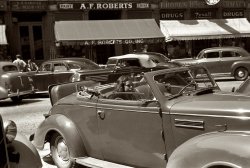
- 40th Street Yard: 1942
- ... & North Western R.R." Kodachrome transparency by Jack Delano. View full size.
Solid Symbol of American Strength What a ... Posted by Dave - 05/19/2017 - 12:24pm -
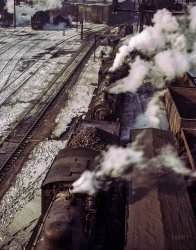
- Vermont State Fair: 1941
- ... 1941. View full size. 35mm Kodachrome transparency by Jack Delano.
Wow-What composition! I am in awe of this photo with the color ... Posted by Dave - 07/29/2012 - 5:58pm -
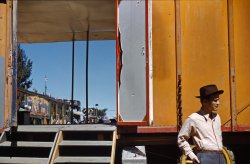
- For Us, Bonds: 1943
- ... Union Station train concourse." Medium-format negative by Jack Delano for the Office of War Information. View full size.
Union ... Posted by Dave - 01/18/2014 - 8:19am -
![For Us, Bonds: 1943 Prequel to the poster seen here.
January 1943. "Chicago, Illinois. Union Station train concourse." Medium-format negative by Jack Delano for the Office of War Information. View full size.
Union Station?Can anyone tell me why so many transportation hubs for rail are called "union" stations? Was Woody Guthrie involved? Why union? Why rail? Not bus or ship.
[The name "Union Station" was generally applied to those used by multiple railway companies. -tterrace]
Increase bomber's altitudeThanks to Michael R for explaining that this section of the building is no longer there. I've been through Chicago's Union Station fairly often and just couldn't recognize the room, even considering years of change. Wonderful photos not only for the moment in time, but one can see where Mr. Delano stood to take his photos. Near center (U.S. flag) on this end, and to one side on the other end of the room (evidenced by the Philippine flag and edge of news stand). Possibly the model bomber hanging from the ceiling blocked a central shot. It's fun to put yourself in the shoes of the photographer.
An aerial armada in miniatureLife magazine - Sept 28, 2042"Symbolically pointing toward Axis capitals, 4,500 models of Army and Navy planes hang from the ceiling of Chicago's Union Station"
This previous Shorpy photo reveals them better.
InterestBonds purchased then matured 40 years later worth about 5 times their cost.
Interest rates were pretty low until the late 60s.
Pink FloydThank you, JeffK, for the link to the 2007 post (https://www.shorpy.com/model-flight-1943) of the Jack Delano photo of the full armada of planes under the ceiling of Union Station in Chicago. One of the commenters there (Jim) notes the video image from Pink Floyd - The Wall (1982, directed by Alan Parker, animated scenes by Gerald Scarfe) of airplanes morphing into crosses, which I highly recommended (found at 2:10 here: http://www.youtube.com/watch?v=MJUuDoRZpyU) -- the full chilling clip of aerial bombardments, as well as the moment itself of planes-to-crosses. Amazing to think this is over 30 years old now.
Union or Non-UnionA "Union Station" was a separate company, jointly owned by each of its tenants who used it.
Other "stations" were owned by a single railroad, though other railroads may have made use of it through "trackage rights" agreements. Non owners may also have used a "Union Station", without ownership, through trackage rights agreements.
By the way, in railroad jargon, NONE of these buildings are "stations", but rather they are depots. A station, on a railroad, is a specific point specified by name in the railroads' Employee Timetable. An Employee Timetable names many locations not known in the Public Timetable. A station may, or may not, have a depot. In other words, a station is a location, a depot is a building.
Two stations, then and nowAbout fifteen years after Union Station lost its concourse, the other last great old Chicago station was lost entirely, despite protests: Northwestern Station. The space it occupied is now the Richard B. Ogilvie Transportation Center, above which is a bank skyscraper, both the work of Helmut Jahn. In the Waiting Room in Union Station, about two blocks away, it's not hard to imagine it's 1942 (until you look at the people), and you halfway expect to see GI's boarding trains pulled by steam engines, bound for places halfway round the world with names like Tarawa or Arnhem, which you've never heard of. In the Richard B. Ogilvie Transportation Center, it's definitely 1990, and you definitely expect to see cellphones, sneakers, no smoking signs, and commuters bound for Irving Park or Crystal Lake, and home.
Union Station: 2014My photo below shows the same location as the 1943 photo.
The walkway at the rear of the 2014 photo is the tunnel under Canal Street labeled "Waiting Rooms" in 1943. Pillars have been added to support the 35-story building built above in 1971.
The tunnel leads to the Great Hall, which IS still its glamorous 1925 self.
It may not be glamorous, but the station serves about 140,000 passengers on a weekday in 2014. In 1943 the number was roughly 100,000. Of course, out-of-town traffic was huge in 1943. Today it's 90% commuters, with much less luggage.
The seating on the left of the 2014 photo is in the spot of the newsstand in the 1943 photo (behind the "Information" sign).
(The Gallery, Chicago, Jack Delano, Railroads, WW2)](https://www.shorpy.com/files/images/SHORPY_8d24899a.thumbnail.jpg)
- Under the Hood: 1943
- ... Our fourth visit to this gas station. Photo by Jack Delano for the Office of War Information. View full size.
A cutie No ... Posted by Dave - 03/26/2014 - 9:59am -
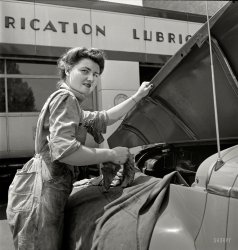
- Lone Wolfsmith: 1943
- ... a suburban train to take him home to Chicago." Photo by Jack Delano, Office of War Information. View full size.
Definitely Bellwood ... Posted by Dave - 09/15/2013 - 10:52pm -
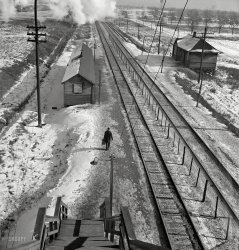
- Airport Newsstand: 1941
- ... Airport near Washington, D.C." Acetate negative by Jack Delano for the Farm Security Administration. View full size.
Bad boy ... Posted by Dave - 01/08/2020 - 7:16pm -
![Airport Newsstand: 1941 July 1941. "The newsstand in the waiting room. National Airport near Washington, D.C." Acetate negative by Jack Delano for the Farm Security Administration. View full size.
Bad boyThat kid is looking at girly magazines!
True ConfessionsBecause once I lived in sin.
SadlyNot one single comic book in sight. There is probably thousands of dollars worth of magazines - if they survived to today - but nothing from the solid gold world of comics. They were probably on a revolving rack, out of camera frame.
Confusion ReignsOh no! They put the Look magazines in the Ladies Home Journal rack! Now I'm totally confused. Or maybe that's the daring new tank top they're talking about.
Lifeless.Looking at the larger image, it's amazing to see how many of those magazines are still in print, like Vogue, Variety, and Better Homes and Gardens, but what *really* amazed me was that I couldn't find LIFE magazine anywhere! There was Look, Saturday Evening Post, and Popular Mechanics, but no LIFE. Must have been sold out. LOL
[Or it's one of the big stacks on the bottom shelf. - Dave]
Smart marketing!The closer the patron got to the cashier, there is what appears to be Wrigley gum. Closer yet are the cigarettes. I could make out the Camel logo. And finally, a cornucopia of cigars. Nothing like tobacco and gum for that plane ride, eh?
At a local grocery store that I patronize, there are gum, breath mints, soft drinks in a cold cabinet, tabloid magazines, the latest DVDs, and finally candy bars right below where you swipe your card.
Nothing has changed.
Daring DetectivePassion murder of the doomed beauty.
Sorry kidYou’ll have to wait a while to find Mad Magazine on those racks.
Priscilla Lane behind the counterAccording to these folks, that's actress, dancer and all-around healthy woman Priscilla Lane on the cover of Physical Culture.
Brings back my smoking daysSeeing the big three -- Camels, Luckies and Chesterfield -- on the shelf reminds of when I started smoking at the age of 12 in 1944. At the time you could get a pack in a machine for 15 cents. With today's prices I couldn't afford it. I had the habit for over 30 years before I wised up and quit.
Smokes and smokin'I'll take a pack of Camels and a copy of Physical Culture, ma'am!
Amazing StoriesNext to bottom shelf, behind the man. September 1941 issue.
Hey kid!Turn around look on the bottom shelf -- Amazing Stories, Fantastic, maybe an Astounding -- they will change your life! They did for me 20 years later.
Color My World.I can't wait to see a colorized version with historically accurate colors of this image. Hint: That's a challenge to all!
P.S. I love the ceiling light fixtures!
Limited-time offer on Agfa filmAgfa had become part of IG Farben in Germany in 1925. In 1939, their US business merged with another company and became General Aniline and Film (GAF), but still used the Agfa brand name in the US, as seen here.
In either late 1941 or early 1942, GAF was seized as enemy property by the US government, and wasn't privatized again until the mid-1960s. This is the same GAF that is known for making roofing shingles today.
Color versionClick here for a version with color issues (as far as I could find them). Below the ones I could find.
(The Gallery, Aviation, D.C., Jack Delano, Stores & Markets)](https://www.shorpy.com/files/images/SHORPY-8c06298a.thumbnail.jpg)
- Hiawatha Noir: 1943
- ... from Union Station." View full size. Photograph by Jack Delano.
Hiawatha Just to let people know, that's the rear of the train, ... Posted by Dave - 09/09/2011 - 6:54pm -
![Hiawatha Noir: 1943 Chicago, January 1943. "Chicago, Milwaukee, Saint Paul and Pacific 'Hiawatha' about to leave from Union Station." View full size. Photograph by Jack Delano.
HiawathaJust to let people know, that's the rear of the train, the last car known as an observation car. Also notice the raindrops falling through the roof ventilation, really neat photo.
[That's snow. - Dave]
A horny spotIt must've scared the bejeezus out of passengers looking out the rear window when they blew that air horn.
HiawathaJust so anybody doesn't think that this is a typical observation car, this was unique to The Milwaukee Road. They made these things themselves in their own shops in their home city. Most other railroads had "store bought" observation cars, either the open platform units familiar from the movies, or the cars typical of the streamliners where the car curves from the sides to the rear.
Front and BackThe locomotive on the Hiawatha was as much a thing of beauty as the "beaver tail" observation car. All designed by industrial designer Otto Kuhler. If this is the "Twin Cities Hiawatha" its 4-4-2 streamlined locomotive has been replaced with an E-6, itself a nice engine but nowhere near as lovely as those steam engines which were said to be the fasted ever produced in the United States (and some say, though without any records to prove it, the fastest steam engine in the world.
Hiawatha formatWhat kind of film format do you think this is? Maybe medium format square?
[2¼-inch square nitrate negative. - Dave]
(The Gallery, Chicago, Jack Delano, Railroads)](https://www.shorpy.com/files/images/3c30645u.thumbnail.jpg)
- Santa Fe Brakeman: 1943
- ... of the cars for the entire distance." Nitrate negative by Jack Delano. View full size.
Fresh Air Ride Does anyone know why the ... Posted by Dave - 06/11/2009 - 11:35am -
![Santa Fe Brakeman: 1943 March 1943. "Brakeman H.B. Van Santford riding on top of the caboose as the train on the Atchison, Topeka, and Santa Fe Railroad goes down from Summit to San Bernardino, California. The swing and head brakeman also ride on top of the cars for the entire distance." Nitrate negative by Jack Delano. View full size.
Fresh Air RideDoes anyone know why the three rode outside? It seems as though it would have been easier to keep that cigarette lit while inside.
Railroad storyI walked up to a brakeman
Just to give him a line of talk
He said if you've got money boy
I'll see that you don't walk
I haven't got a nickel, not a penny can I show
He said get off you railroad bum
And he slammed that boxcar door
-- "Singing Brakeman," Jimmie Rodgers
Perhaps a Little GrandstandingAutomatic air brakes eliminated the need for brakemen to run across the tops of cars applying and releasing brakes at the command of whistle signals from the locomotive. However, Mr. Van Santford does cut a gallant figure as he peers ahead looking for hot brakes or other mechanical ailments.
[Or maybe the descent from Summit required extra caution. - Dave]
Be AwareDo not confuse the Santa Fe Brakeman with the Wichita Lineman.
Life Imitates PublishingIt's right out of Jack Kerouac, from the time when he was writing about being a brakeman in California.
These days nobody gets to be on top of the train. That's less from safety rules than from the fact that they've eliminated the crews. "A train without a caboose is like a sentence without a period."
Up on the RoofAs noted in the caption, the train is descending a grade and the train carries three brakemen – head end riding the engine, rear who normally rode the caboose and "swing" riding mid-train (another Delano photo shows a swing brakeman riding and standing on a car roof as the train goes downgrade, which was standard practice here.
Brakemen would ride the roofs to watch for any sign of trouble (over-heated or burning journals ("hotbox"), burning brakes, line-side fires etc) — in this era, cars still had roofwalks and high-mounted handbrake gear, so if there was a failure or problem with the airbrakes as they descended, they could move from car to car and set the handbrakes in an effort to slow things down.
(The Gallery, Jack Delano, Railroads)](https://www.shorpy.com/files/images/8d27585u.thumbnail.jpg)
- Tater Tot: 1940
- ... Does this beat Introduction to Algebra? Photo by Jack Delano. View full size.
Now Batting For Lew Hine, number 44, Jack ... Posted by Dave - 06/20/2013 - 10:37pm -
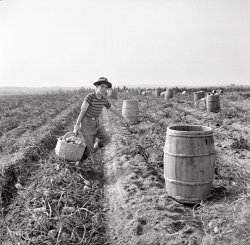
- Modern Forest: 1941
- ... in Midland, Pennsylvania." Medium format negative by Jack Delano for the Farm Security Administration. View full size.
Now ... Posted by Dave - 11/04/2019 - 2:45pm -
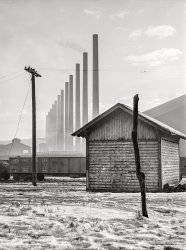
- The Watchers, Watched: 1940
- ... contest in Presque Isle, Maine." 35mm nitrate negative by Jack Delano. View full size.
Wow I wonder if that little girl grew up to ... Posted by Dave - 09/03/2012 - 1:17am -
![The Watchers, Watched: 1940 October 1940. "Spectators at the annual barrel rolling contest in Presque Isle, Maine." 35mm nitrate negative by Jack Delano. View full size.
WowI wonder if that little girl grew up to be Kim Novak or Eva Marie Saint.
Pretty BlondeI speculate the young lady will be breaking the hearts of some returning soldiers in a few years.
Barrel Rolling Must Not Have Been FunNobody is smiling. They'd have even less reason to smile in another two months' time.
[I see two people smiling. - tterrace]
[And as far as "two months' time" goes, you're a year off. - Dave]
SmilingRe: "Nobody is smiling." What do you mean? My maternal family is from Maine and Vermont. They ARE smiling!
You lookin' at us?It's hard to tell which unsmiling expression is more interesting -- the curious girl's, the disgusted woman's, the bemused man's or the very alert dog's.
SmilesFor Mainers those ARE smiles. They are practically grinning!
Presque Isle's FinestPresque Isle, Maine is pretty close to the end of the road. Way, way up in northern Maine, beyond the northern terminus of I-95. Even today, the roughly 400 mile drive from Boston would take a good 7-8 hours, assuming you kept moving and didn't hit a moose along the way. In 1940, when US Route 1 was the only way to get there, it could easily have taken a couple of days.
Yet, there she is. Up there in the middle of nowhere, surrounded by nothing but potato farms and the Great North Woods, sits a stunning vision of beauty, a girl any 12-year old boy would easily and quite happily fall hopelessly, eternally in love with. My goodness!
(The Gallery, Dogs, Jack Delano, Kids)](https://www.shorpy.com/files/images/SHORPY_8a34570a.thumbnail.jpg)
- Knock Knock: 1943
- ... Hammond, Indiana. Locomotive coupled to caboose." Photo by Jack Delano for the Office of War Information. View full size.
Thumper Ah ... Posted by Dave - 10/07/2013 - 12:24pm -
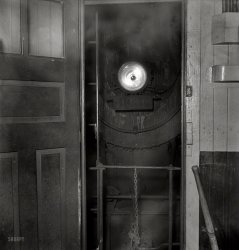
- Cane Sugar: 1942
- ... Puerto Rico Sugar Company plant." Acetate negative by Jack Delano. View full size.
Geared up for production "Now, crawl up this ... Posted by Dave - 03/28/2019 - 8:45pm -
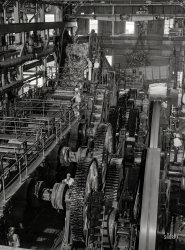
- City of Los Angeles: 1942
- Detail from Jack Delano's shot of the C&NW railyards in December 1942, and streamliners ...
...........Vern..............
(The Gallery, Jack Delano, Railroads) ... Posted by Dave - 12/28/2007 - 7:58pm -
![City of Los Angeles: 1942 Detail from Jack Delano's shot of the C&NW railyards in December 1942, and streamliners City of Denver and City of Los Angeles. View full size.
The one that's not yellowWhat is that red and white one? (Or red-white-and-???)
City of Los Angeles?Ok, please explain the title, it simply cannot be correct.
[The name of the right-hand train, written on the side, is City of Los Angeles. - Dave]
LocomotivesCan't tell you about the red and white one - it looks like a 'B' unit. It could be a leased locomotive ('B' units were unmanned diesel locomotives controlled from the cab of the 'A' unit) but that in itself was puzzling because before the war at least the Union Pacific's "City" trains all ran with matched sets of locomotives, with the name of the train (City of Los Angeles, City of San Francisco, City of Denver, etc) painted on each unit of the train. At that time you'd never see a 'B' unit from the City of San Francisco on the City of Los Angeles - let alone a mismatched 'B' unit. War is hell.
The middle locomotive (the one without a train attached) is a Chicago & North Western E unit, most likely an E6 like the locomotive on the City of Los Angeles. There's no indication of what train its part of so it could be either the C&NW's own "400" or one of the trains the C&NW and UP operated jointly, like The Challenger.
The outermost locomotive is probably the most interesting stylistically. It's one of the CD series (CD-05, 06, or 07) - the CD standing for the City of Denver. That's written on the side of the locomotive but you really have to blow it up to see that detail. The cab was elevated above the main body of the engine. The distinctive grille is primarily decorative, a holdover from the first streamliners on the UP, M-1000 through M-1002. Indeed the CD locomotives were originally numbered M-1003 through M-1006. Sadly none of the CD locomotives were preserved.
Red White BlueWar is hell, indeed...I "think" the red/white unit is actually red white and blue special paint promoting war bond purchases, I recall reading something about this one long ago but can't begin to be able to prove this now. Blue band is hiding in the shadow. Rare catch it is.
Red White & BlueThere is a RR boxcar "State of Maine" that is red white and blue. A photo of it can be seen at www.davestrains.com. Their catalogue #3494-295
City of Los AngelesBelow, a black-and-white photo of the red, white and blue City of Los Angeles, from the October 19, 1942, Pennsylvania Evening Standard. (The word "stamps" is just visible in the color photo above.) The caption reads:
STREAMLINED SELLING: A streamlined supersalesman of war bonds is the streamliner City of Los Angeles. Train was decked with banner urging purchase of war bonds and stamps. Inspecting it are Howard D. Mills of Treasury Department (left) and W.H. Guild, executive assistant, Union Pacific Railroad. Banner's colors are red, white and blue.
Credit: NewspaperArchive.com
Red White & BlueThat is amazing detective work. How did you find that? I had been trying to figure the mystery out.
[I searched NewspaperArchive.com for "City of Los Angeles" and "streamliner" and "red" in the year 1942. - Dave]
CoLAThe most useful text on the subject of the UP "City" trains is William Kratville's "Union Pacific Streamliners" (1974). The windows on the unit make me want to say it's an EMD model E-6 unit, quite possibly LA-4 (the lead unit of a 3 locomotive set which was permanently assigned to the 1941 edition of the City of Los Angeles streamliner).
Yellows, Grays, Greens & BrandsThe photo displays equipment of two distinct "brands" at Chicago. The "Armour Yellow" and Gray, signature Union Pacific RR (UPRR) colors for its widely promoted "City" fleet of Streamliners. It was the work of Chicago & Northwestern (C&NW) to handle the moves between Chicago and Omaha, UPRR gateway for the West.
The Green and Yellow motive power units, in the signature colors of the C&NW "400" Streamliner, service lanes between its on line points. Premier service lane between Chicago and Twin Cities. For the Operations folks, I'll conjecture a hard and fast rule did not permit intermixing of equipment. IMHO, the scene is at the area "wash" line...
...........Vern..............
(The Gallery, Jack Delano, Railroads)](https://www.shorpy.com/files/images/1a34616u1.thumbnail.jpg)
- Rara Avis: 1941
- ... Rico. In a dress factory." Medium format negative by Jack Delano for the Farm Security Administration. View full size.
Puerto ... Posted by Dave - 03/10/2019 - 10:44pm -
![Rara Avis: 1941 December 1941. "San Juan, Puerto Rico. In a dress factory." Medium format negative by Jack Delano for the Farm Security Administration. View full size.
Puerto Rican sweatshop workerIt's Puerto Rico and a sweatshop, but I don't think our modista is Puerto Rican.
[She is, and I'm not sure why you might think otherwise. - Dave]
Winding the bobbinI always wound a bunch of bobbins up ahead of time. Never thought to wind them as I sewed.
I was puzzled by the headline... until I zoomed in.
Genetic engineering, 1941-styleWe crossed a human with a pigeon, and got a Puerto Rican sweatshop worker.
OK ...I see the feathers now.
And furthermoreRara Belleza!
Nomenclatura ObscuraI generally get a chuckle out of the titles heren, but you nearly got me this time till I caught the feathers.
(The Gallery, Factories, Jack Delano, Pretty Girls, Puerto Rico)](https://www.shorpy.com/files/images/SHORPY-8c09013a1.thumbnail.jpg)
- Fayetteville at Five: 1941
- ... when the workers start coming out of Fort Bragg." Photo by Jack Delano. View full size.
What's he standing on? Is what he's ... Posted by Dave - 10/04/2021 - 1:13pm -
![Fayetteville at Five: 1941 March 1941. "Traffic on the main street of Fayetteville, North Carolina, at about five o'clock, when the workers start coming out of Fort Bragg." Photo by Jack Delano. View full size.
What's he standing on?Is what he's standing on still there?
[Planet Earth? Last we checked, yes. - Dave]
Twist of FayettevilleThere have been a lot of changes in downtown Fayetteville. This looks approximately right - Rayless department store was at 200 Hay St. There is no more parking, and the street has been narrowed with many trees planted. I can spot at least 3 surviving buildings on the right, including the old McFadyen Music.
It looks like the original photo was taken from the balcony of the Market House. You can see it in street view if you swivel 180 degrees.
Is that a Lincoln?The fifth car back on the left, the light-colored one. I need help from the Shorpy auto buffs.
I have lived here since the 70sYes, he will have been standing on the west balcony of the Market House, it was recently in the news due to an attempted arson during the riots last summer. The debate is still open as to what should be done with it, tear it down, move it, or?
I remember many of the buildings in the picture, many started going away by the late 70s and early 80s as the downtown area fell apart and shopping moved out to the malls. Quite a few of the buildings are still there but heavily renovated. The Hotel Lafayette is long gone, The Prince Charles is still there and is currently housing rental condos and small businesses. Downtown has come, gone, and come again.
My guess is ChryslerI'm thinking this is a 41 Chrysler Series 30 Eight
5th car on leftI don't believe so. The Continental had a different trunk lid and rubber mudguard on the front of the rear fender, and the Zephyr rear was more sloped. Could be wrong though.
5 p.m. Fort Bragg exodus?I lived on Fort Bragg when my dad was stationed there in the early '60s and it's highly unlikely any end-of-the-day traffic from the post would be noticed in downtown Fayetteville 13 miles away.
[Fayetteville was home to thousands of construction workers engaged in a massive wartime expansion of Fort Bragg -- the reason this series of photos was made. - Dave]
No, it's not a LincolnThe shape of the rear fender, the three horizontal ribs, and the location of the filler cap leave no room for guessing – it's a 1941 Plymouth P12 Special Deluxe.
McFayden MusicI was a little surprised to find out that McFayden Music is still in business, though now they are in Greenville, according to their website!
Fayetteville Street LifeI suppose the trees planted along the sidewalk in present-day Fayetteville are nice, and I know there is an anti-automobile sentiment in many towns, large and small, that results in limited street parking, narrower roads, bike lanes, pedestrian priority rights-of-way, etc. But I can't help but notice the vibrancy of street life in Fayetteville back in 1941. The streets are lined with shops, and there is exuberant signage everywhere. There are actual pedestrians - shoppers, workers, people running errands - walking on the sidewalks. The street is bustling with traffic. Today? It looks kind of quiet and desolate - although I bet the local shopping mall and the Wal-Mart and the Home Depot out by the Interstate are full of consumers.
(The Gallery, Cars, Trucks, Buses, Jack Delano, Stores & Markets)](https://www.shorpy.com/files/images/SHORPY-8c04841a.thumbnail.jpg)
- Polar Express: 1942
- ... View full size. 4x5 Kodachrome transparency by Jack Delano.
Footsteps Galore Just an incredible amount of footsteps in the ... Posted by Dave - 07/30/2012 - 10:03pm -
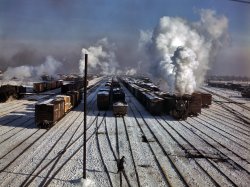
- Oil and Water: 1943
- ... between Winslow and Seligman." Medium-format negative by Jack Delano, Office of War Information. View full size.
From the future ... Posted by Dave - 04/30/2014 - 4:46pm -
![Oil and Water: 1943 March 1943. "Ash Fork, Arizona (vicinity). Passing an eastbound freight on the Atchison, Topeka & Santa Fe Railroad between Winslow and Seligman." Medium-format negative by Jack Delano, Office of War Information. View full size.
From the future looking pastIt appears that our vantage point is from a diesel locomotive looking onwards as a steam engine will come past us. I really want to guess that this is an EMD FT engine that we are riding.
[He's on the locomotive shown below. - Dave]
PortholesThe portholes are the round windows visible in this previous Shorpy photo and the pic posted by Phare Pleigh in the comments.
Little change in the landscapeI believe this is the track that parallels I-40. I drove it eastbound from California 5 weeks ago, and it didn't look any different!
LocoI was thinking the same thing -- FT it could be! Maybe an early F3? What do you suppose the wooden barricades are along the R.O.W.? Protection for a culvert?
[Those are the wings of the cattle guards. They prevent cattle from sneaking around the grids, and are angled to accommodate passage of varying train and car widths. --tterrace]
Four portholesidentify these as FT's at 1350 HP per unit. The F-3 model wasn't built until after the war.
SorryWhat 'port holes'? Where would they be.
Water is rightThese units were an exception to the general embargo on diesel unit construction during the war; they were permitted due to the difficulty of getting good water supplies across the desert.
Milepost 398That white pole alongside the steamer must be Milepost 398 (from Albuquerque); Delano is looking WSW from about 35.239N 112.446W. The hill beyond the windshield wiper is Picacho Butte, 35.229N 112.741W.
(The Gallery, Jack Delano, Railroads)](https://www.shorpy.com/files/images/SHORPY_8d27376u.thumbnail.jpg)
- The Ritz: 1940
- ... Coaldale, Pennsylvania." Medium format acetate negative by Jack Delano for the Farm Security Administration. View full size.
Lansford ... Posted by Dave - 11/29/2018 - 2:14pm -
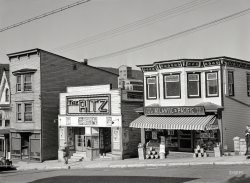
- Ghost Factory: 1941
- ... Works in Beaver Falls, Pennsylvania." Acetate negative by Jack Delano for the Farm Security Administration. View full size.
(The ... Posted by Dave - 04/06/2022 - 4:35pm -
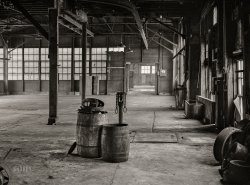
- Fire-Eater: 1942
- ... North Western Railroad shops." Medium-format negative by Jack Delano for the Office of War Information. View full size.
The 400 In ... Posted by Dave - 07/30/2014 - 7:42pm -
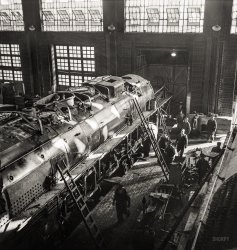
- The Georgia Line: 1941
- ... Georgia. Children at the school." Acetate negative by Jack Delano for the Farm Security Administration. View full size.
Mission ... Posted by Dave - 02/21/2019 - 2:23pm -
![The Georgia Line: 1941 October 1941. "Siloam, Greene County, Georgia. Children at the school." Acetate negative by Jack Delano for the Farm Security Administration. View full size.
Mission accomplishedJack Delano proves his extraordinary abilities here in that he has every child’s face visible within the frame of this unusual point of view shot.
Look outSome of those kids look downright diabolical. But I think the girl in the striped dress is calling the shots.
Talk about linesDave, the titles you apply to all these great photos are a classic in themselves! Many thanks for all those 'extra' LOL's!!!
[We do what we can. - Dave]
(The Gallery, Education, Schools, Jack Delano, Kids, Small Towns)](https://www.shorpy.com/files/images/SHORPY-8c07385a1.thumbnail.jpg)
- North by Night: 1940
- ... buy anything from clothing to Coca-Colas." Photo by Jack Delano -- Farm Security Administration. View full size.
Where's ...
(The Gallery, Cars, Trucks, Buses, Gas Stations, Jack Delano, Stores & Markets) ... Posted by Dave - 05/02/2021 - 3:03pm -
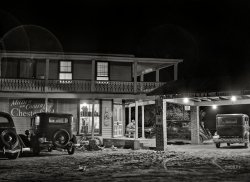
- Argentine Yard, Kansas City: 1943
- ... 1943. View full size. 4x5 Kodachrome transparency by Jack Delano.
Argentine Yard History of the Argentine Yard:
...
(The Gallery, Kodachromes, Jack Delano, Railroads) ... Posted by Dave - 08/05/2012 - 6:32pm -
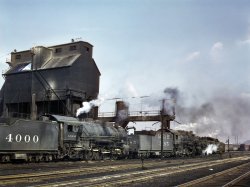
- Work From Home: 1941
- ... Corporation in background." Medium format negative by Jack Delano for the Farm Security Administration. View full size.
I ... Posted by Dave - 12/23/2018 - 12:25pm -
![Work From Home: 1941 January 1941. "Scene in west Aliquippa, Pennsylvania. Stacks of the Jones and Laughlin Steel Corporation in background." Medium format negative by Jack Delano for the Farm Security Administration. View full size.
I don't know a thing ... about the Farm Security Administration. It's hard to imagine a government agency with such a mundane handle could produce an artist like Jack Delano. I'll bet they never knew.
[Not to mention Dorothea Lange, Gordon Parks, Walker Evans et al. - Dave]
The Coming War YearsI love these snapshots in time. A year after this photo was taken, the steel mills of Pennsylvania would soon be working overtime for the war effort.
(The Gallery, Factories, Jack Delano)](https://www.shorpy.com/files/images/SHORPY-8c04647a.thumbnail.jpg)
- Well Oiled: 1943
- ... Refining Company garages." Medium-format negative by Jack Delano for the Office of War Information. View full size.
Pretty Girl ... Posted by Dave - 04/05/2017 - 6:10pm -
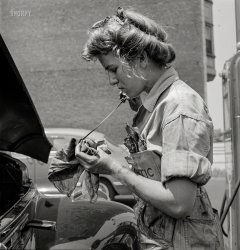
- The Mourners: 1941
- ... back from a funeral." Medium-format nitrate negative by Jack Delano. View full size.
Sure you can take our picture A unique ... Posted by Dave - 04/13/2013 - 3:45pm -
